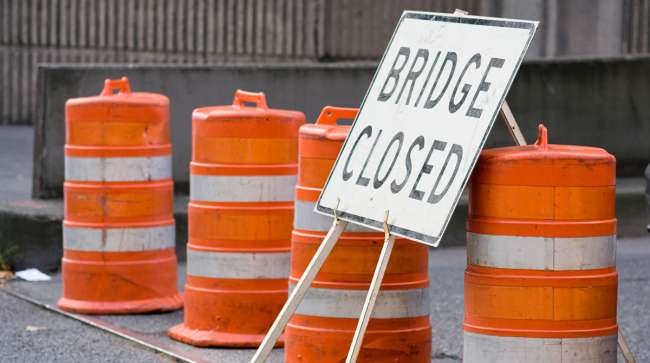Bridge Strikes Vex New England Cities

Some New England cities have a problem that they want truck drivers passing through to know about — bridges may be too low for their rigs.
In Dover, N.H., the Broadway rail bridge has been hit at least 42 times in the past five years, according to Dover police data. But that’s no match for the Cambridge Street rail bridge in Worcester, Mass., which has been hit 62 times in the past five years.
However, 72% of those collisions came between 2013 and 2014. Since 2015, after the city workers added a warning system, it’s been hit 17 times.
According to the Worcester Police Department statistics, the 12-foot, 6-inch rail Cambridge Street bridge was hit 31 times in 2014, including twice in 15 minutes. The bridge strikes in 2014 marked a 121% jump from the 14 hits recorded in 2013.
Worcester Commissioner of Public Works Paul Moosey told Seacoast Sunday that while the bridge, built in the 1800s and owned by Providence & Worcester Railroad, always has been struck by vehicles, the hits only increased a few years before 2014. Moosey doesn’t have evidence to confirm why it occurred more, but he suspects it has to do with GPS routing.
Part II in my trucks hitting bridges series. In this episode, we look how Worcester (almost) solved its bridge crises. While Dover’s bridge was hit 42 times in 5 yrs, trucks hit Worcester’s 31 times in one year alone. @FostersDailyDem https://t.co/ezixkt41Rk — Brian Early (@briantemprano) August 26, 2018
Cambridge Street is a busy commercial corridor in Worcester, Moosey said, and the bridge is located close to an Interstate 290 interchange. In 2014, many city businesses became agitated, and the City Council demanded solutions. The city manager had proposed a $5,000 fine every time the bridge was hit.
Richard Kazarian, a branch manager for NorthEast Electrical Distributors located about 200 feet away from the bridge, was fed up. When a truck got stuck under the bridge, it could lead to lengthy road closures. Often cargo had to be removed from the stuck vehicle and loaded into another vehicle. The truck also had to be removed, and bridge inspectors had to make sure it was safe, Kazarian told Seacoast Sunday. There also were numerous emergency vehicles parked all around. He said the business effectively was closed after a hit because the entrance to the company was blocked.
In 2014, Kazarian recommended to the Worcester City Council to install a sensor system that would flash an alert on the bridge if a truck was too tall for it. Kazarian said NorthEast Electrical was willing to donate the sensors for the project.
Moosey, a 34-year veteran of Worcester Public Works, contemplated a sensor-activated warning system. But he soured on the idea from a similar system the city used in areas that often flood when it rains. “We spent quite a bit of money for that system,” Moosey said. “That seems to be broken as much as it works.”
At 9-feet, 6-inches, many trucks can't fit under the railroad bridge just outside downtown Dover, but not for a lack of trying. @fostersdailydem https://t.co/pEXlSDpMzC — Brian Early (@briantemprano) August 5, 2018
Instead, DPW members created height clearance curtains, a pole with chains dangling down. At the end of the chains are “big rubber things,” Moosey said. At the top of the pole is a yellow sign: “Trucks that hit this will hit bridge.” When a truck hits the chains, it makes a loud sound but doesn’t damage the trucks, he said.
The curtains were installed in late 2014 or early 2015. The difference was dramatic. In 2015, only four strikes were recorded, a 675% decrease, according to Worcester police. However, a handful still occurs each year. “There isn’t a foolproof way to do this,” Moosey said.
He didn’t have a cost of what it took to install, but he said it was a cheap fix made from materials the DPW already had. One challenge, however, is the chains getting tangled. When the chains get tangled, their level rises higher off the ground. Kazarian believes the tangled chains have led to bridge crashes because truck drivers clear the chains and assume they have clearance to go under the bridge when they don’t.
While Moosey isn’t clear how the chains get tangled, Kazarian said it typically occurs on one side where trucks can build up speed. When trucks hit the chains at a faster speed, Kazarian speculates they get tangled. Moosey said DPW crews have made adjustments to the chains to keep them from tangling up as much.
Distributed by Tribune Content Agency, LLC

